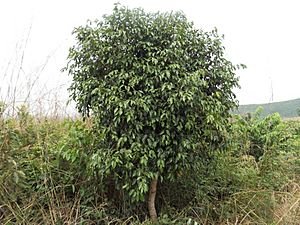Syzygium guineense facts for kids
Quick facts for kids Syzygium guineense |
|
|---|---|
 |
|
| Scientific classification | |
| Genus: |
Syzygium
|
| Species: |
guineense
|
| Synonyms | |
|
S. staudtii (Engl.) Mildbr. |
|
The Syzygium guineense tree, also known as Kokisa in some places, is a beautiful leafy tree found in forests across Africa. It belongs to the Myrtaceae family, which also includes plants like eucalyptus and guava. You can find this tree growing wild, but people also plant it in their gardens.
Both the fruits and leaves of the Syzygium guineense are safe to eat! People often suck the sweet pulp and skin of the fruit and then throw away the seed. Sometimes, this tree is called "waterberry," but remember that other trees in the Syzygium family might also share this name.
Contents
About the Syzygium Guineense Tree
Syzygium guineense is a tree that can look quite different depending on where it grows. Because of these differences, scientists have had many discussions about how to best classify its types. For example, one botanist named Frank White described four main types, or subspecies, of this tree. One of these types is a suffrutex, which means it's a small shrub that has woody stems at its base but softer, non-woody stems above.
How the Tree Looks
Most Syzygium guineense trees grow to be about 10 to 15 meters tall, which is like a three or four-story building. But some really tall ones have been found reaching up to 25 meters!
The trunk of the tree is wide and has grooves, and its top part, called the crown, is round and full. When the tree is young, its bark is smooth. As it gets older, the bark becomes rough and turns black. Its branches often hang downwards, and the younger stems are thick and have angles.
Leaves and Flowers
When the leaves first appear, they are a pretty purple-red color. As they get older, they turn a dark green. The leaves are shiny and smooth on both sides, with a long but rounded tip. They grow on a short, grooved stalk.
The flowers of Syzygium guineense are quite lovely. They have bright white parts called stamens, which are the parts that produce pollen. These flowers grow in dense, branched clusters that can be up to 10 centimeters wide. They also have a sweet, honey-like smell that attracts many different insects, helping the tree to make new seeds.
Where the Tree Grows and Its Uses
In southern Ethiopia, the Syzygium guineense tree is very popular. People love to plant it near their homes and in their gardens because it provides excellent shade from the sun.
You can find wild forms of this tree growing from sea level all the way up to high altitudes of 2,100 meters (about 6,900 feet). It likes to grow in moist soil, especially near rivers where there's a lot of water underground. However, it can also grow in open woodlands.
Sometimes, this tree is called a "famine food." This means that subsistence farmers, who grow food mainly for themselves and their families, eat its fruits when their main crops don't grow well. It's a helpful plant that can provide food when other sources are scarce.

